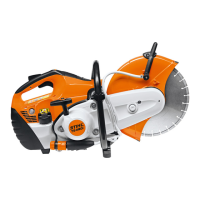TS 480i, TS 500i
English
23
N Curves must be cut in several
straight passes, taking care to
ensure that the cutting wheel does
not become wedged. Do not
attempt to correct the position or
direction of a cut by tilting or twisting
the machine or cutting wheel. If
corrections are necessary, always
lift the machine and reposition the
cutting wheel, taking care to ensure
that it is not wedged, tilted, twisted
or side loaded.
Cutting Pipes or Other Round, Hollow
Bodies
The procedure is dependent on the
outer diameter of the object being cut,
the maximum possible cutting depth of
the abrasive cutting wheel (A), and
whether the pipe or other body can be
rolled during the cutting process. The
maximum cutting depth for abrasive
cutting wheels with a 14" diameter is
4.9 in. (125 mm). For cutting wheels with
a 12" diameter, it is 3.9 in. (100 mm).
N Secure and support pipes and other
round, hollow bodies against
sagging, slipping, dropping, moving,
rolling or vibrating.
N Determine the sequence of the cuts.
N Determine the weight, tension and
the likely direction of fall of the part
to be severed.
N Determine and mark the cutting line;
avoid rebar and other metal
reinforcement to the extent
possible, especially in the direction
of the severing cut.
N Determine and mark the direction of
the cut.
N Cut a shallow guide groove along
the line marked.
N Make cuts progressively deeper
along the guide groove. Observe
the recommended cutting depth for
each pass. If corrections are
necessary, always lift the machine
and reposition the cutting wheel,
taking care to ensure that it is not
wedged, tilted, twisted or side
loaded. Attempting to change the
position or direction of a cut while
the wheel is in the cut can bind the
wheel. This can lead to kickback,
other reactive forces or a shattered
composite cutting wheel, which
could result in severe or fatal
personal injury.
N If necessary, leave small sections
that hold the part that is to be
separated in position. Break these
sections manually with a hammer or
other appropriate tool after making
the last cut.
If the outer diameter of the pipe or other
round, hollow body is smaller than the
maximum cutting depth of the wheel:
N Make one cut from the top to the
bottom of the pipe.
If the outer diameter of the pipe or other
round, hollow body is greater than the
maximum cutting depth of the wheel:
Plan first, then cut. The sequence shown
in this manual is illustrative and not
meant to substitute for the judgment of
the experienced workmen with actual
knowledge of on-site conditions.
However, the last cut must always be
made in such a way that the cutting
wheel cannot become pinched, bound
or clamped and so that the operator, co-
workers and bystanders are not at risk of
being injured by a falling part that has
been cut off or out, by cutting debris or
sparks. Generally, this should be in the
002BA528 AM

